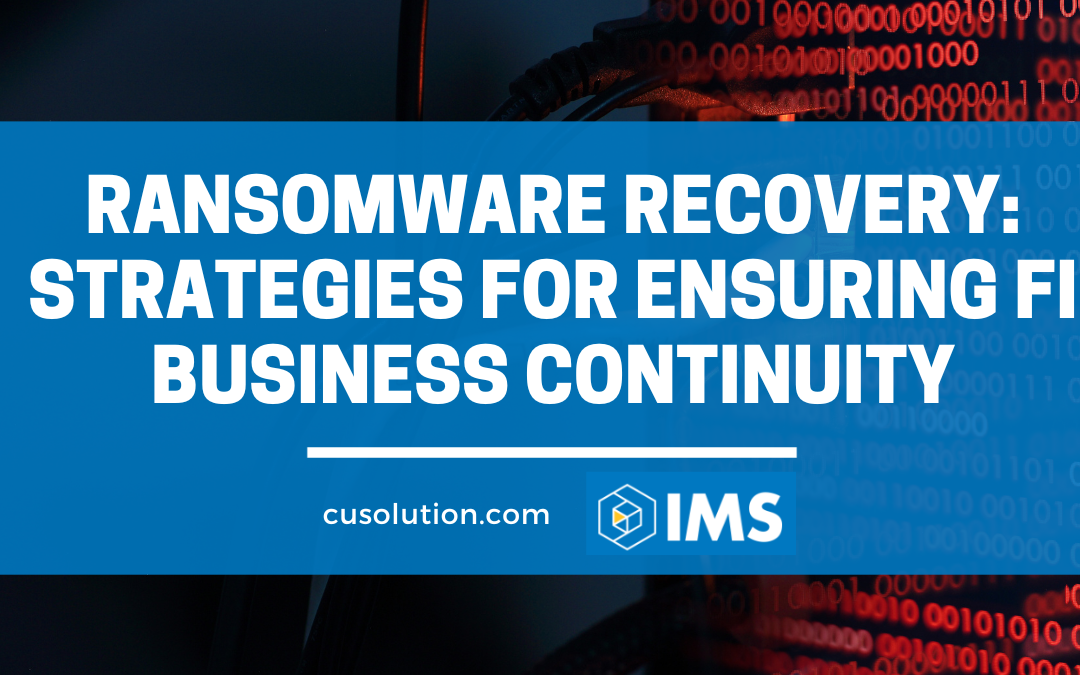In December 2023, a devastating ransomware attack targeted the cloud services provider Ongoing Operations, causing a widespread outage that impacted numerous credit unions. This incident served as a wake-up call for financial institutions and credit union leaders, highlighting the urgent need for robust business continuity strategies in the face of evolving cyber threats. Today we will explore the key steps credit unions can take to establish business continuity in the aftermath of a ransomware attack, ensuring the resiliency and security of their operations.
Understanding the Impact of a Ransomware Attack and the Importance of Business Continuity
A ransomware attack is a malicious cyber attack in which cybercriminals infiltrate a network, encrypt data, and demand a ransom payment in exchange for the decryption key. The consequences of a successful ransomware attack can be severe, ranging from financial losses and operational disruptions to reputational damage and legal liabilities. For credit unions, the impact of a ransomware attack can be particularly devastating, as it can compromise sensitive customer data and disrupt critical financial services.
The Ongoing Operations Ransomware Attack
In December 2023, the credit union industry experienced a major ransomware attack targeting Ongoing Operations, a prominent cloud services provider. This attack resulted in a widespread outage that affected numerous credit unions, causing disruptions to online banking services, member communication, and internal operations. The incident served as a stark reminder of the vulnerabilities faced by credit unions in the digital age and the need for proactive measures to mitigate the risks associated with ransomware attacks.
Building Resiliency Against Ransomware Attacks
To establish business continuity in the aftermath of a ransomware attack, credit unions must adopt a multi-layered approach that encompasses robust cybersecurity measures, comprehensive backup and disaster recovery solutions, and proactive incident response strategies. Let’s explore these key elements in detail.
1. Strengthening Cybersecurity Measures
Effective cybersecurity measures form the foundation of any business continuity strategy. Credit unions should implement a comprehensive set of cybersecurity controls to protect their networks, systems, and data from ransomware attacks. These measures may include:
- Endpoint Protection: Deploying advanced endpoint protection solutions to detect and block malicious software before it can infect the network.
- Network Segmentation: Implementing network segmentation to isolate critical systems and data from potential threats, limiting the spread of ransomware.
- User Awareness Training: Conducting regular cybersecurity awareness training programs to educate employees about the risks associated with phishing emails, suspicious links, and other common attack vectors.
- Patch Management: Keeping systems and software up to date with the latest security patches to address known vulnerabilities that can be exploited by ransomware.
By strengthening their cybersecurity measures, credit unions can significantly reduce the risk of a successful ransomware attack and enhance their overall resiliency.
2. Implementing Anomaly Detection Systems
Anomaly detection systems such as IMS’ Polaris Radar play a crucial role in early detection and prevention of ransomware attacks. These systems use advanced machine learning algorithms and behavioral analytics to identify abnormal patterns and activities that may indicate the presence of ransomware or other malicious activities. By monitoring network traffic, user behaviors, and file activity, anomaly detection systems can quickly detect and respond to potential threats, minimizing the impact of a ransomware attack.
3. Backup and Disaster Recovery Solutions
Having robust backup and disaster recovery programs is essential for establishing business continuity in the aftermath of a ransomware attack. Credit unions should implement regular, automated backups of critical data and systems. These backups should be stored in secure, offsite locations to ensure their availability in the event of a ransomware attack or other data loss incidents.
Additionally, credit unions should regularly test their backup and disaster recovery processes to ensure their effectiveness and reliability. Conducting mock recovery exercises can help identify any gaps or vulnerabilities in the backup strategy, allowing credit unions to make necessary improvements and adjustments.
4. Incident Response and Recovery Planning
In the event of a ransomware attack, a well-defined incident response plan is crucial for minimizing the impact and restoring normal operations as quickly as possible. Credit unions should develop a comprehensive incident response plan that outlines the roles, responsibilities, and communication protocols for responding to a ransomware attack. This plan should include:
- Incident Identification and Reporting: Clearly defining the process for identifying and reporting a ransomware attack to the appropriate stakeholders, including internal IT teams, management, and external incident response partners.
- Containment and Mitigation: Outlining the steps to contain and mitigate the impact of the ransomware attack, such as isolating affected systems, disconnecting them from the network, and implementing temporary measures to restore critical services.
- Communication and Notification: Establishing communication channels and protocols for notifying affected parties, such as employees, customers, regulatory authorities, and law enforcement agencies. Timely and transparent communication is crucial for maintaining trust and managing the reputational risks associated with a ransomware attack.
- Recovery and Restoration: Detailing the procedures for recovering encrypted data, restoring affected systems from backups, and implementing additional security measures to prevent future attacks.
By having a well-prepared incident response plan in place, credit unions can minimize the downtime and financial losses associated with a ransomware attack, allowing them to recover and resume normal operations swiftly.
Securing Business Continuity: Resilient Strategies
In today’s digital landscape, credit unions face increasing threats from ransomware attacks. Establishing business continuity in the aftermath of such attacks requires a comprehensive approach that combines robust cybersecurity measures, effective anomaly detection systems, reliable backup and disaster recovery solutions, and well-defined incident response and recovery planning. By prioritizing resiliency and taking proactive steps to mitigate the risks associated with ransomware attacks, credit unions can protect their operations, safeguard sensitive data, and maintain the trust of their members.
At IMS, we understand the importance of establishing business continuity in the face of evolving cyber threats. Our comprehensive suite of anomaly detection, backup, and disaster recovery solutions are designed to help credit unions increase their resiliency and protect against ransomware attacks. Connect with us to learn more about how IMS can support your credit union’s business continuity efforts.

